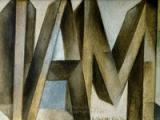What happened that day?
See historic events for any day of the year by entering the date below. Why not try your birthday?
Kiwi of the Week
Today in History

1987 Death of Colin McCahon
Colin McCahon is regarded as one of New Zealand's greatest painters. A risk-taker and non-conformist, he engaged with questions of religion, faith and the human condition through his art.
Born in Timaru in 1919, McCahon claimed that his desire to paint came from watching a signwriter working on a tobacconist's shop window as a child. As a high school student he was inspired by Toss Woollaston's first exhibition, and the celebrated landscape painter was to become a lifelong friend and mentor. McCahon trained at the Dunedin School of Art, and received a Carnegie Grant to study in the US in the 1950s, but was otherwise largely self-taught.
A common thread throughout McCahon's career was his exploration of Christian themes. His art, which he himself claimed to be autobiographical, traces a personal spiritual journey. It reveals a slow transition from faith to doubt, the final paintings of the early 1980s expressing a sense of despair.
One of McCahon's great frustrations was people's failure to understand his paintings. His desire to communicate ideas led to his innovative use of words, speech bubbles, numbers and familiar Christian symbols in his art. McCahon resisted explaining his meaning, even to his family and friends; he wanted viewers to rely on the visual cues. For many, though, his paintings remain compelling but enigmatic.
Colin McCahon's paintings continue to resonate with viewers today and are the subject of much discussion and research. They are held in major public and private collections throughout the country and in many collections worldwide.
Image: 'I Am' (Colin McCahon Research and Publication Trust)














